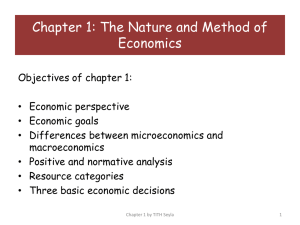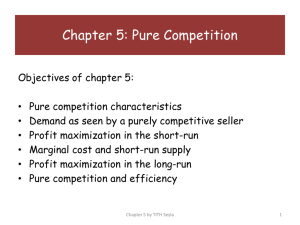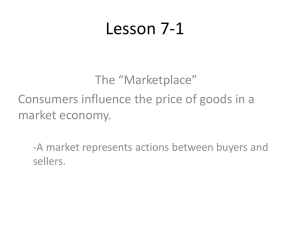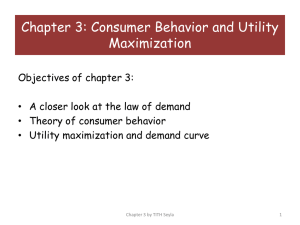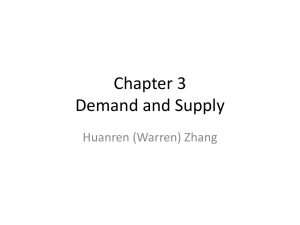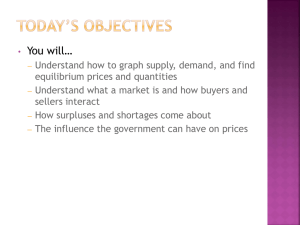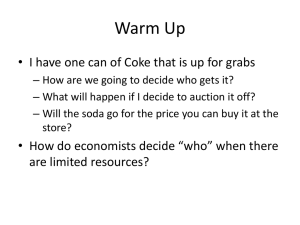Market Demand
advertisement
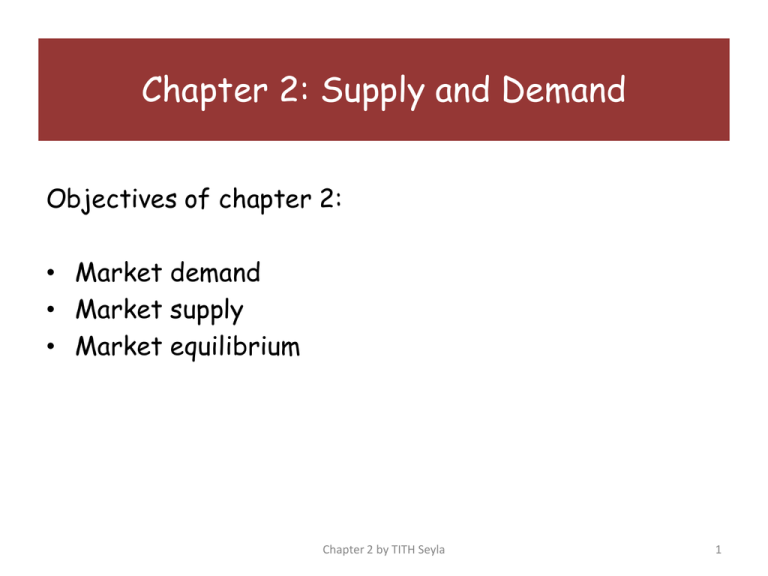
Chapter 2: Supply and Demand Objectives of chapter 2: • Market demand • Market supply • Market equilibrium Chapter 2 by TITH Seyla 1 Introduction – A market is a group of buyers and sellers of a particular good or service. – Buyer determine Demand – Seller determine Supply Chapter 2 by TITH Seyla 2 Market Demand (a) • Definition – Demand for a goods or service is defined as quantities of goods or service that people are ready to buy at various price within some given time period, other factors beside price held constant. – Ready to buy = willing + ability • Law of demand – When the price of a product goes up, the quantity demanded for this product goes down. – When the price of a product goes down, the quantity demanded for this product goes up. • Changes in the quantity demanded results from changes in the price of the product. (Movements along the demand curve) • Changes in demand results from changes in the non-price determinants. (Shift in the demand curve) Chapter 2 by TITH Seyla 3 Market Demand (b) Chapter 2 by TITH Seyla 4 Non-price determinants of demand (a) • Tastes and preferences – Personal likes and dislikes of consumers for various goods and services. • Income – The money you earned to spend on goods and services. • Prices of related products – The substitute products: A or B is OK! – The complement product: A or B is not OK! A + B is OK! • Future expectations – Expectations of the buyers on the rises or the falls of the price of the goods and services. • Number of buyers – The larger the number of buyers, the larger the demand. Chapter 2 by TITH Seyla 5 Non-price determinants of demand (b) Chapter 2 by TITH Seyla 6 Market Supply (a) • Definition – Supply for a goods or service is defined as quantities of goods or service that people are ready to sell at various price within some given time period, other factors beside price held constant. – Ready to sell = willing + ability • Law of supply – When the price of a product goes up, the quantity supplied for this product goes up. – When the price of a product goes down, the quantity supplied for this product goes down. • Changes in the quantity supplied results from changes in the price of the product. (Movements along the demand curve) • Changes in supply results from changes in the non-price determinants. (Shift in the supply curve) Chapter 2 by TITH Seyla 7 Market Supply (b) Chapter 2 by TITH Seyla 8 Non-price determinants of supply (a) • Costs and technology – Cost of production such as labor costs, costs of materials, rent, interest payments, depreciation charges, and general and administrative expense. – Technological innovations or improvement in the product process such as automation, robotics, computer aided processes, etc. that reduces the unit cost of the product. • Prices of other goods and services offered by the seller – The case of competing products such as pizza & hotdog. • Future expectations – Expectations of the sellers on the rises or the falls of the price of the goods and services. • Number of sellers • Weather conditions Chapter 2 by TITH Seyla 9 Non-price determinants of supply (b) Chapter 2 by TITH Seyla 10 Market equilibrium (a) • Demand and supply met in the market – What happen when the demand and the supply of a product are met in the market? • The market equilibrium is a situation in which the quantity supplied and quantity demanded of a product is the same at a unique price. • The unique price is called the ‘equilibrium price’. • The quantity supplied and quantity demanded (which are equal) is called the ‘equilibrium quantity’. • Market surplus: D < S at a given price -> price falls to P*. • Market shortage: D > S at a given price -> price rises to P*. Chapter 2 by TITH Seyla 11 Market equilibrium (b) Chapter 2 by TITH Seyla 12
